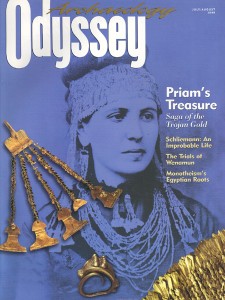Archaeology Odyssey, July/August 1999
Features
Priam’s Treasure
The story behind the 4,000-year-old hoard of Trojan gold
Heinrich Schliemann’s second season of excavation in 1872 on the mound of Hisarlik, which he fervently believed to be the site of Homer’s Troy,1 had ended in triumph. He had discovered, so he thought, the “Great Tower of Ilium”—which Hector’s wife Andromache anxiously climbed upon learning that...Read more ›
Who Owns Priam’s Treasure?: An Odyssey Debate
Discovered at Troy; smuggled to Greece, bestowed upon Germany; confiscated by the USSR—Schliemann’s gold is still causing a ruckus.
Return the Treasure to Germany Why should the events of World War II abrogate longstanding agreements over cultural ownership? Priam’s Treasure belongs in Berlin’s Museum of Pre- and Early History, part of the German system of federal museums. Heinrich Schliemann excavated the Trojan hoard in 1873. It...Read more ›
Priam’s Treasure in Boston?
On at least two occasions, the famous Trojan gold nearly found a home in the United States. On May 31, 1873, Schliemann uncovered what he later described as Priam’s Treasure. Within days he had smuggled the entire lot out of Turkey to Athens—where he set the finds...Read more ›
Heinrich Schliemann: Improbable Archaeologist
Athens at the height of summer. Visitors are negotiating their way through the crowded Mycenaean room of the National Museum. The name “Schliemann” rustles through the air as the guides halt their groups at strategic points and launch into their mini-lectures on the finds. The tourists gaze...Read more ›
Monotheism
The Egyptian roots
Among the many features of Western intellectual history that can be traced to the ancient Near East, none has been more powerful than the idea of transcendental monotheism—the belief in only one god who exists eternally and apart from his creation. The early Hebrews are generally given...Read more ›

